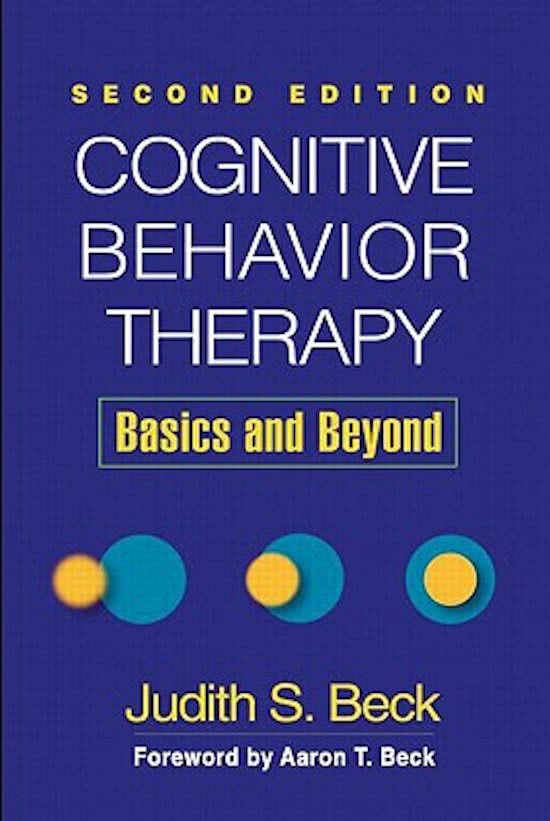--------------------
INTRODUCTION TO COGNITIVE
BEHAVIOURAL THERAPIES
PSB3E-KP07
--------------------
1
,Lecture 1 – 17 november
1st 3 weeks: behavioural therapy (Farmer)
4-5 cognitive therapy (Beck)
6-7 third wave therapies
What characterizes CBT?
Cognitive, behaviour, exposure.
It’s an empirically based form of treatment, departing from theoretical models on learning and
information processing.
Short history
50-60’s: 1st generation. Observable behaviours. Focussed on behavioural interventions (like
exposure therapy)
70’80’s: focussed much more on cognitive therapy (information processing – select
information, where we draw attention to, how we memorize it, etc.). Focus on thoughts and
challenging these thought using questioning. (Think Socrates: ‘The only thing I’m going to do
is ask questions. I’m not giving you answers’. Let them think about it)
80’s: integrated into CBT (these two together).
2000’s: 3rd generation. Mindfulness based, Acceptance and commitment therapy, Dialectical
Behaviour Therapy: how you think about (see/perceive) the thoughts that you have; rather
than trying to change them.
Characteristics of CBT
- Focus on present (in stead of: think of your childhood; go back and back). Might be
good to know how you developed the problem, but it doesn’t really help to solve it.
Break/make a change: focus on what’s maintaining the problem. Focus on thoughts,
behaviours, emotions.
- Time-limited. Work towards goal. Not just ‘see where it ends’. No progress after 10
sessions – there’s no reason to go on. Think about alternatives.
- Building on theoretical and clinical research. Proper evidence for the fact that it
works.
(Remember the think, feel, behave triangle à intervening in one of these things, will
change the others. So think differently, will make someone start to feel and behave
differently)
Structure of CBT
- Validation of complaints
- Building therapeutic relationship/engagement (How do you built this? Evidence says:
therapeutic relationship changes once you actually do your interventions. So the
relationship will grow as soon as you start interventions.)
- Explaining general treatment rationale (You are aware of what you’re going to do, but
tell them the theory behind the therapy)
- Cognitive and behavioural assessment (Once you see how problems are maintained,
you get ideas of how it can be intervened. Be concrete and realistic. Not just: ‘I want
to get my life back together’. You can’t change the situation but you can change how
they deal with it.)
- Formulating realistic goals (I can learn you to deal with depression and make sure you
feel you’re better able to deal with the situation)
- Designing treatment plan
2
, - Carrying out treatment plan (Maybe start over again several times)
- Broadening to other areas of dysfunctioning
- Relapse prevention (Because relapse is high in all disorders)
Aim: investigate exact nature of patient’s thoughts
Initial approach (see ppt)
Maintenance (see ppt)
Video
CBT works well for: depression, anxiety, panic disorders (obsessive compulsive disorder)
Therapy involves: person makes sense of problem and understands it. Make it practical.
Confront those fears. Find out what’s going on and find a way of tackling it. Prove that
nothing terrible happens after not washing hands in a dirty situation.
CBT is about making it possible to reclaim life in terms of things that they want to happen.
Not particularly take the bad things away.
Definitions
- Applying experimentally verified information
- Behaviour is a logical response to a meaningful situation
- Acquiring knowledge about the connection between events (expectations) can result in
a behavioural change. So: a distinction between learning (expectation) and
performance (behaviour)
Levels of knowledge
Learning model. The ways of developing, maintaining and changing behaviour are the same
across all people. Normal or abnormal? Deficit or excess. Norm = always general. What’s the
norm? Could be anything.
1. Procedure – how do you do things (manipulation focussed on learning effect)
2. Learning principal – what is the effect
3. … see ppt
EMDR
Eye Movement Desensitization and Reprocessing
Moving object in combination with talking about upsetting thoughts.
Eye movements are effective. May be linked to REM (rapid eye movement) – making life
more manageable, like in the REM sleep. Processing mechanism gets disrupted when trauma
occurs. When we deal with eye movement, we seem to be opening up that block. Also
possible by clicking sound. Image gets more neutral every time. Then connect the image to a
positive sentence: ‘I can handle this, to look at is’.
à how it started: someone noticed eye movement during walk in the park and based a whole
theory on it. Procedure was very clear. EMDR turned out to be effective in reducing PTSD
(PTSS) symptoms. Science was very sceptical but then it actually worked.
à PTSD: EMDR or CBT
à They do like to promote their own therapy: can be dangerous. We have to be critical when
EMDR is taken to all kinds of disorders.
à explanations for effectiveness. Experimental research
Do eye movements actually have an affect on disturbing images? Group recalls the memory,
other group recalls memory + eye movements. Results: vividness went down (huge decrease).
3
, For emotionality also a major decrease. Group that recalled it only just a slight decrease.
Means that eye movements do seem to add something.
Then: going up and down or left and right. Equally effective.
Then: came up with a theory. Working memory theory. When you think of an event, it will
take up all your memory space. But working memory capacity is quite small. Simultaneously
other task that takes up space, means that there’s just not enough room to keep the memory
100% alive. Emotionality and vividness of the memory will fade.
Also possible: do Tetris, hear beeps (smaller effect though) or perform mathematical tasks.
Conclusions for CBT interventions
- Important that we know how to do it (clear procedure)
- Established effectiveness (relationship)
- Empirical evidence
CBT is dominant therapy in the Netherlands. Attractive because it’s short-term and
measurable. VGCt largest association in NL
Find what’s evidence based in: ggz richtlijnen, nice guidelines, psychiatryonline.
CBT is not perfect
- 50/60% reach recovery (in ideal circumstances). 40% don’t. That’s a lot, but we don’t
have anything better at the moment.
- We can think about how to improve this to 100% but there’s a problem here. Lot of
therapists have beliefs toward CBT that are not helpful for the patient. They rarely use
manuals and dislike them; they know better. Even though there is empirical evidence
that if manuals are used, the results will be better.
- Also, therapists believe the therapeutic alliance will do lots of the work. 32% of the
therapists think that bad relationship with client will cause worse results. Evidence
turns out to be just 4-5%! Does the alliance drive therapy outcome? It doesn’t! It’s
more important to focus on behavioural change. You like to be a nice therapist but it’s
not the best thing for the patient. You are going to ask them to do things that are
difficult. If they don’t do it, it’s not going to work. In the end they will love you for it.
Too much empathy is not good in therapy.
- Your patient is going to be distressed. Face those emotions instead of being liked.
Otherwise CBT isn’t working. So, before we go on towards striving to the 100%, we
need to make sure that the therapists that we have actually do get to the 60%. The 40%
is unexplained. We don’t know on beforehand who will benefit from CBT and who
won’t.
- The best indicator of therapist drift. I’ve done this so often, I know what works.
Actually, after a number of years it gets worse because you think you’ve seen it
before. After that, it will go up again, because you realize you haven’t seen it all
because everyone turns out to be different (see the table in the ppt: timespan of one
year). In the beginning, you stick to the protocols and to the manuals.
Basic principles of BT
Interaction of person with his/her environment (there’s a certain situation, then, in that
situation (antecedents), you’ve got the actual behaviour. That behaviour has a certain
consequence. So it’s this we need to investigate.
During intake evaluation: assessing problem behaviour, coping behaviour, registration of
problem behaviour etc.
- Discriminative stimuli (Sd) – events that elicit the behaviour
4






